Portugal is a country of olive oil, bread, and wine. And of these three, usually, two go into soup. Speaking of Portuguese gastronomy without talking about soup is possible, but incomplete.
Soup is part of most Portuguese people’s day to day life (even though we are eating less soup than we were 30 years ago). The repertoire of Portuguese recipes is not only old and varied, but it is also a valuable treasure that helps us to understand the history, geography, and anthropology of its many regions.
If we consider the discovery of fire, and that the first culinary technique was roasting meat or other foodstuffs over a fire, boiling was in all likelihood one of the immediately succeeding techniques to be developed. initially, through boiling water with hot stones in animal organs and skins, or even baskets, and later in watertight clay containers. Naturally, with the boiling of meat, fish, or vegetables, comes broth… and soup.
The concept of soup is not hard to define; soup is a liquid food of variable consistency, that results from the boiling of foods in water, and is composed by solid parts (vegetables, meat, fish, bread, etc.) and a liquid part, which is called broth. It is, in its essence, a simple and highly nutritious food.
BROTHS (CALDOS) & BREAD SOUPS
Broth (caldo) may be defined as the liquid part of the soup, simply the water from boiling foodstuffs, or otherwise a soup with a very thin consistency, that may or may not contain chopped up ingredients. In the case of Portuguese soups, the usefulness of this dubious. Some recipes are called broth but are nothing like a broth.
The word soup comes from the germanic term “suppa” which means “piece of bread soaked in liquid”, and by extension “broth poured over bread”. It is therefore assumed that bread is the ancient base for soup, thickening and giving texture to the broth through its starches. Soup became an important source of repursoning old bread, and avoiding food waste. There are, of course, other bases for soups, composed in general ofstarches or dairy, that thicken the broth and create soup.
A few centuries ago, broths were also considered medicine, and we can find (sometimes quite bizarre) broth recipes for all kinds of ailments, such as “broth for chest inflammations”, or “viper broth to purify the blood”, or even “frog and snail broth for dry cough”, all of these and many more present in “Cozinheiro Moderno” by Lucas Rigaud (1780).
From the broths we may find throughout Portugal, we will see in further detail the caldo de unto, but also the canja de galinha (below). There are many others to point out, such as the caldo de castanhas piladas (chestnut broth) from Minho, which is traditionally savored on Lent Fridays or St. Bartholomeu’s day. Also from Minho comes the caldo de rabo de boi (oxtail broth), while the canja de perdiz (partridge broth) is from Trás-os-Montes, or Lisbon’s caldeta de amêijoas (clam broth).
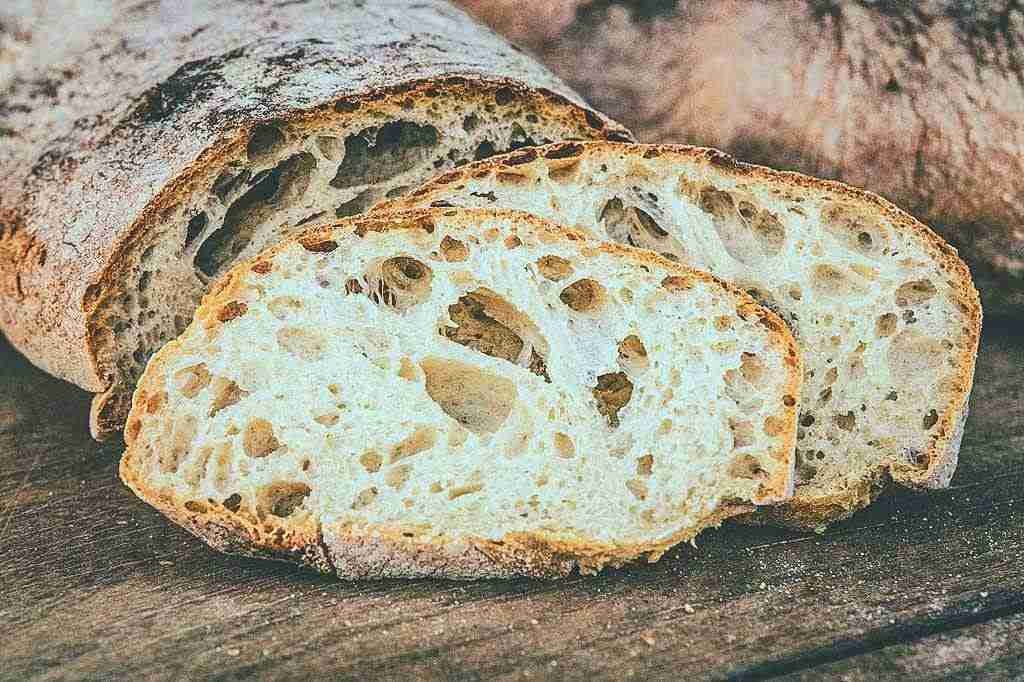
As for bread soups, in Portugal, the more the merrier. As mentioned before, the use of bread to turn the broth into soup is primitive, probably millenary, particularly in the Mediterranean region. Bread is one of the cornerstones of the Southern European diet, and Portugal, with all its rich and diverse breadmaking history, is no exception. More than a vehicle to any filling, bread served as a pivotal energy source for countless generations. To illustrate its importance, we can quote as an example the life of a 17th-century fieldworker: he/she would eat as much as 1 kilogram of bread a day, besides broth, vegetables, a little meat or fish, and a lot of wine.
The respect for bread was unquestionable, so it was only convenient to avoid its waste to the maximum. Thus, far and wide throughout the country, old and stale bread was included in a myriad of repurposing recipes, from savory to sweet. The use of bread in soups and migas was presumably the most common.
If we reflect upon which bread soup most commonly crosses the Portuguese mind, we might come upon the conclusion that it is the humble and delectable açorda, which we will describe more attentively below. Nonetheless, we’ll find specimens like the ferventados from Beira Litoral, which are very simple bread soups made by boiling fish like codfish and sardines, meat like lamb or pig bones, or even vegetables. Sopas secas (“dry soups”), which use the leftovers of the traditional cozido also have bread as a star ingredient. Other examples include sopa de lebre (hare soup) and sopa de pão com tomate (bread and tomato soup) from the Algarve, and sopa de alheiras (alheira sausage soup) from Trás-os-Montes, and sopa da panela (“pot” soup) and the sargalheta from the Alentejo, however, there are countless Portuguese soups that integrate bread with more or less emphasis, simply because bread is an essential and ubiquitous ingredient.

ÁGUA OU CALDO DE UNTO
North & Beira Alta
Água de unto — literally, “fat water” — is a classic and ancestral broth is that we can observe in the region of Minho, but also Trás-os-Montes. Água de unto is not more than water that boils with unto (fat that can be found between the pig’s nipples and the peritoneum), onion, and olive oil, to which bread is finally added, and sometimes also eggs. Besides thrifty, this is a light soup, that traditionally was served as breakfast for field workers and shepherds. A similar broth is the caldo de unto from Beira Alta, which does not contain bread, but instead, eggs.

CANJA DE GALINHA
Countrywide
Canja de galinha (chicken broth) is probably the best known Portuguese broth. Beloved by many, avoided by some (who associate it to being sick), canja is a timeless broth that crosses generations and social strata. Some people will swear upon its healing properties for the ill, and nutritious qualities for parturients.
The recipe is, as you would expect, simple. The broth is prepared by boiling a chicken with a series of seasonings, and finally by adding rice (more recently, small pasta or even tapioca may be added) that will cook in the broth. Finally, the dish may be garnished with mint leaves, strips of chicken meat and offal, and with delicious unlaid eggs (immature eggs that are still inside the chicken). There are other canjas throughout Portugal, like the canja de bacalhau (codfish) or the canja de conquilhas (bean clam).
It is believed that the canja originally came from Southeast Asia, the fruit of the voyages of the Portuguese during the Discoveries. Conjee, or rice broth, is distributed throughout most of Asia, but its origin is believed to be in India. It was probably in Goa that the Portuguese first came into contact with this broth, which is still very relished in the region. It’s unclear whether canja originates from kanji (from the Tamil “boiled” or “rice boiling water”) from the region of Tamil Nandu or pez from the region of Konan. Indeed, the name “canja” appears to be an adaptation of the word kanji, as the Portuguese doctor and naturalist Garcia de Orta referred in 1563: “They give them to drink water from rice with pepper and cumin (to which they call canje)”.

AÇORDA ALENTEJANA
Alentejo
To better understand the açorda‘s origin, one needs to remember the arrival of the Moors in the Iberian Peninsula in the 8th century AD. The Arabs introduced not only an immeasurably valuable agricultural heritage but also a far-reaching gastronomical legacy that lasts until this day. In it, we can identify the tharîd (“shredded soaked bread” in Arab), or ath-thurda, in the Andaluz dialect, which is accepted to be the father-figure of the açorda.
Strictly speaking, the açorda is a leftover meal, in which the pauper’s creativity finds glory. The base is always the same. In a simpler version, it is composed of stale bread, as well as garlic and salt that are smashed in a pestle & mortar. Then, all is doused with boiling water and then seasoned with some olive oil and herbs like cilantro and pennyroyal. Poached eggs are also usually added. From thereon, one may add other ingredients such as codfish, river fish, or sardines. It is a brothy soup with a profoundly aromatic character and a singular consistency created by the bread.

GASPACHO & ARJAMOLHO
Alentejo & Algarve
Now, for a bread soup that reminds us of summer (as it is cold), we have the gaspacho. Not to be confused with its Andalucian counterpart (one has to exchange an “s” for a “z”), the Alentejo’s gaspacho has its distinctive features. The biggest of which is possibly the fact that it is not crushed. According to the monumental Traditional Portuguese Cooking by Maria de Lourdes Modesto, to make a gaspacho you need to smash garlic and salt, add some olive oil, vinegar, oregano, some crushed and cubed tomato, as well as cucumber, and thinly cut bell pepper. All is then submerged in cold water, and bread cubes are added upon serving. In the Algarve we will find arjamolho, which is in all similar to gaspacho, but with different ingredient proportions.
Both the gaspacho and the arjamolho as we now know them are of ancient origin, but the appearance of bell peppers and tomato in Portugal only dates back to the 16th century, when the Spanish first brought them from South America to Europe. Both soups are believed to be much older than that and thus made with the same ingredients, except for the South American fruits.
MEAT SOUPS
Meat soups are an important part of the Portuguese cuisine. More substantial, and quite naturally, richer, meat soups can be a meal in themselves.
To make meat soups, Portuguese cooks may gather supplies from the cow barn, the pig pen, the chicken coop, or even from the wilderness… the source of protein is varied and depends on the region. However, it wouldn’t be surprising that most Portuguese soups are basked on pork, either fresh or smoked/cured, and more than often, the swine are used from snout to tail. As examples, we may quote the jantar de matança (slaughter’s dinner) from Beira Baixa, that contains bones, bacon, skin, and chouriço, or the mythical and substantial sopa da pedra (stone soup) from Ribatejo, and the sopa dos ossos da cabeça de porco (pig’s head bones soup) from Beira Litoral. Not to mention the sopas de cozido and the sopas secas, which we will develop further below.
There are also meat soups with various sources of protein, such as the gluttonous sopa do Espírito Santo (soup of the Holy Spirit) from Azores, notably from Ilha Terceira and Faial, which contains beef meat, liver and blood, as well as chicken, mint, cinnamon, cabbage, and other bits and bobs. As far as game meat soups go, we have the example of Algarve’s and Alentejo’s sopas de lebre (hare soup), as well as the sopa de perdiz (partiridge soup) and sopa de pombo-bravo (wild pigeon soup) from Trás-os-Montes.

BLOOD SOUPS
Countrywide
The use of the entire animal is one of the pivotal features of Portuguese cuisine. Soups are no exception to this rule, and we can find examples throughout the country. For example, the sopa de miolos de porco (pork brain soup) and the sopa de orelheira (pork ear soup) from Trás-os-Montes, or the sopa de rabo de boi (oxtail’s soup) from Lisbon.
However, one of the ingredients which commonly appears in Portuguese soups is blood. There is no need to tie comparisons to the infamous Spartan black soup, as the Portuguese versions are true delights (and not frights). We can immediately pinpoint the sopas de sarrabulho (Minho) in their several variants, made with organ meats such as pork liver and lung, as well as boiled pork blood, chicken, and thickened with cornflour. Other examples include the sopa de sangue (blood soup) from Trás-os-Montes, the laburdo from Beira Interior, or the sopa de sarapatel from the Alentejo (in this case using lamb or goatling blood). In general, these are soups that are usually associated with the animal slaughter season, but also on special occasions, like eating sarapatel on Easter in Castelo de Vide.
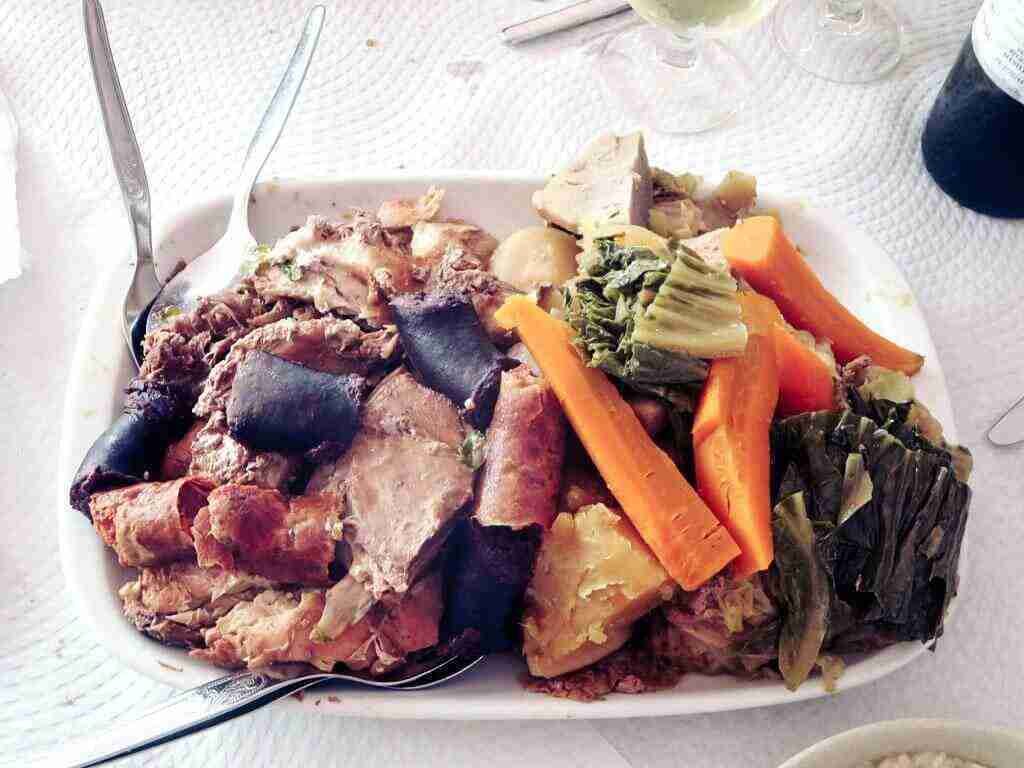
SOPA DE COZIDO & SOPAS SECAS
Countrywide
The cozido is an omnipresent dish in all Portuguese territory, but it is not uncommon to other areas of Europe (e.g. the French pot-au-feu), with variations in content. In Portugal, it is usually composed of a selection of the best local meats, either fresh or cured (where it can get very specialized). This is an old dish, potentially with Jewish heritage — of course, without pork. Beyond meats, it includes vegetables that mirror the vegetable patches of the region, such as different cabbages, carrots, potatoes, turnips, and chickpeas, as well as other variants.
Boiled are the various components, the precious and nutritious broth that remains is wisely used for some side dishes, as is the arroz de cozido (cozido rice), and more importantly, the sopa de cozido (cozido soup). The sopa de cozido is a tasty and simples broth rich in meaty, smokey, vegetable flavors, and is an amalgamation of warm and comforting flavors that reminds us of a hearth in the winter months. Better still, the broth can survive to a further meal, which is a leftover dish called sopa seca (dry soup). The sopa seca takes advantage of the leftovers from the cozido, by chopping up the meats and vegetables and placing them in a clay container, then covered with bread and broth, and taken to the oven to crispen. There is also a sweet version of sopa seca, so be careful not to mix them up!

RANCHO
North
Rancho is another classical northern meat soup and is commonly eaten as a main dish on cold winter days, given the robustness of its composition. There are different recipes according to the region (Viseu, Trás-os-Montes or Minho), but in general, rancho is made up of chickpeas, potatoes, pork, cow, or chicken meat, cured meats, sausage, pasta, as well as carrots and cabbage.
VEGETABLE SOUPS
Vegetable and legume soups are common throughout the country, and play a big role in the Portuguese diet. These soups are made with horticultural products from all regions, but also with wild plants. When it isn’t a role for bread, vegetable soups are often thickened with potatoes, which in the old day would have been achieved with chestnuts, and more recently using chayote (Sechium edule), a small gourd from Central America, or otherwise with squash puree.
Portuguese soups use practically all cultivars, encompassing legumes of all colors, all sorts of greens, tubers, fruits, roots, and sprouts. Sometimes, these soups are indiscriminate, a mixture of any available greens which we would call “sopa de legumes” (legume soup) — which is only accurate when it contains legumes!
In the old day, vegetable soups would have been a faithful reflection of each home’s vegetable garden, adapting to the seasons and the outcome of the crops. The vegetable garden represented an important role in the family’s diet and was always a guarantee of food in times of scarcity.
Some notable or curious examples of vegetable soups are the illustrious caldo verde (kale and potato soup) from Minho, sopa de tomate (tomato soup) from Alentejo, sopa de feijão frade (black-eyed pea soup) and the requentado from Ribatejo, sopa de trigo (wheat soup), and sopa de moganga from Madeira, made from moganga pumpkin (also known as chila or gila), but also the lesser-known sopa de chícharos (Lathyrus sativus, or grass pea) from Estremadura, or even sopa de casúlas (bean pod soup) from Trás-os-Montes.
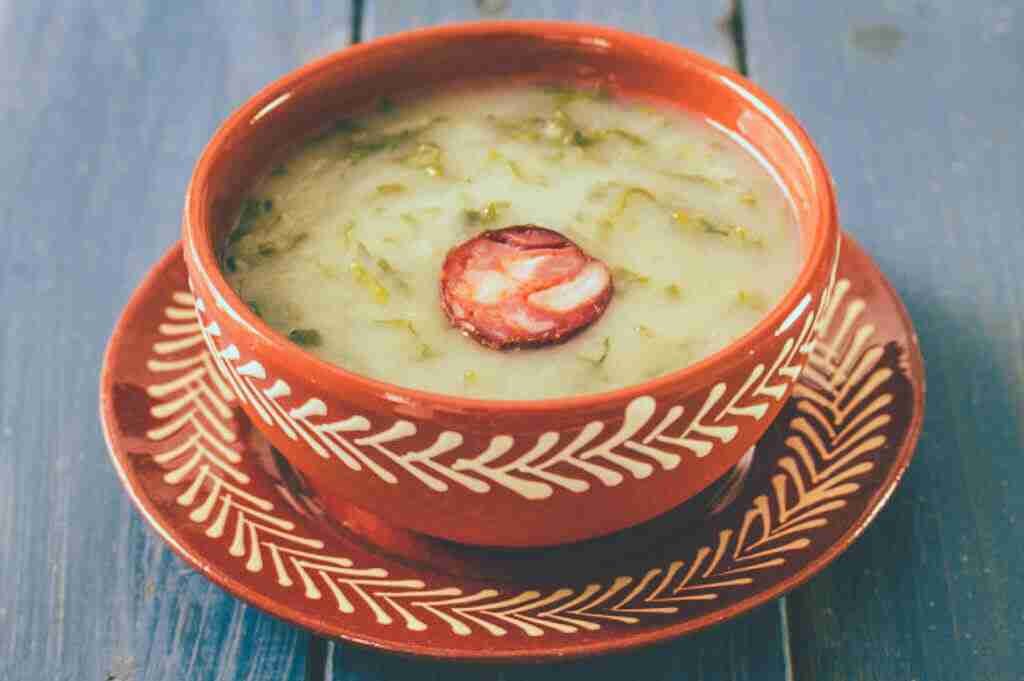
CALDO VERDE
Minho
Unquestionable icon of Minho’s gastronomy, caldo verde is uncontested royalty. Kind of any gathering, best friend of a grilled sardine, caldo verde is a symbol of traditional Portuguese soups. Without surprise, it became popular also in Brazil.
The name — green broth — isn’t a tell. It’s not (strictly speaking) a broth, and it’s only partly green (also yellow). Made with a base of potato, onion and garlic, which are smashed, and then to which finely shredded Galician kale is added, just before the soup is ready. The soup is then garnished with a slice of chouriço or salpicão for flavor, and a little more olive oil. And then, of course, we need some sliced of broa (thick cornbread) in close range.
Little is known of the true age of caldo verde, as Galician kale has grown for centuries in the Minho region, but potatoes have only been grown there since the 16th century. It’s to be settled whether a caldo verde without potato would have been possible, or if it were rather made with bread, or even chestnuts, which were then switched to potato.

WILD SOUPS
Countrywide
Although they are becoming scarce in current menus, traditional Portuguese cuisine incorporates many recipes with wild plants. The reason for the inclusion of these wild ingredients — especially in regional cuisines that heavily rely on these plants, as is the case of Alentejo — is that throughout several moments in history, the population found itself in need, and in shortage, creativity and invention arise. Thus, plants, roots, fungi, and herbs that otherwise would be disregarded were stifling hunger and turning into singular dishes.
In Portuguese soups, we may find the use of watercress (Nasturtium officinale), nettles (Urtica dioica), purple amaranth (Amaranthus lividus), beet (Beta vulgaris), curly dock (Rumex crispus), spinach (Tetragonia tetragonoides), fennel (Foeniculum vulgare), purslane (Portulaca oleracea), asparagus (Asparagus aphyllus), golden thistle (Scolymus hispanicus), and mushrooms — which are fungi, and not plants — like túberas (Terfezia spp., a truffle-like fungi) or yellow knight (Tricholoma equestre).
There is also an enormous variety of spontaneous aromatic plants that are also used in Portuguese soups, such as pennyroyal (Mentha pulegium), many varieties of thyme (Thymus spp.), mint (Mentha viridis), bay (Laurus nobilis), Hart’s pennyroyal (Mentha cervina), and oregano (Origanum vulgare), amongst others.
But back to soups: in Trás-os-Montes, we can find wild soups such as sopa de beldros (purple amaranth soup) or sopa de urtigas (nettle soup), while in Beira Interior, we can find sopa de poejos (pennyroyal soup) and sopa de fiolho (fennel soup), whereas in the Alentejo, sopa de túberas com ovos (truffle-like fungi and egg soup), sopa de carrasquinhas (golden thistle soup), and sopa de beldroegas (purslane soup). As expected, there are many other examples, more or lesser documented, throughout the country.
SEAFOOD SOUPS
The intimate relationship between Portugal and the ocean easily translates into soups. We may find seafood soups from north to south, even in areas that historically struggled to find marine fish.
Fishermen, unsurprisingly, played a great contribution toward seafood recipes. In their boats, fishermen prepared meals with fish or fish parts that were commercially expendable and later scattered these recipes within their hometown communities.
Logically, traditional fish and shellfish soup recipes mostly feature species that are found within the waters that surround their respective regions. But the not even a great distance to the coast compromised the appearance of marine seafood in interior regions. Dried fish soups appeared especially in areas where only river fish like trout or nase would be found fresh. Dried fish was commonly sold in fairs and markets, and stored throughout the year. In the long list of Portuguese soups, we see multiple sopas de bacalhau (codfish soups) that pop up all over the country, but also cases like sopa de solha seca (dried sole soup) from Lanhelas (Minho), sopa de sardinha de barrica (barreled sardine soup), sopa de congro (conger eel soup), sopa de peixe seco (dried fish soup) from Trás-os-Montes, or sopa de sarda (mackerel soup) and sopa de cação (dogfish soup) from the Alentejo, despite nowadays the use of fresh dogfish and conger eel being more common.
Migratory fish — and thus seasonal — also have a special feature in some parts of the country. It’s the case of Aveiro’s sopa de enguia (eel soup), or even the sopa de lampreia (lamprey soup), made from that frightfully delicious cyclostome that is so prized in the Minho, as is the bony allis shad (sopa de sável).
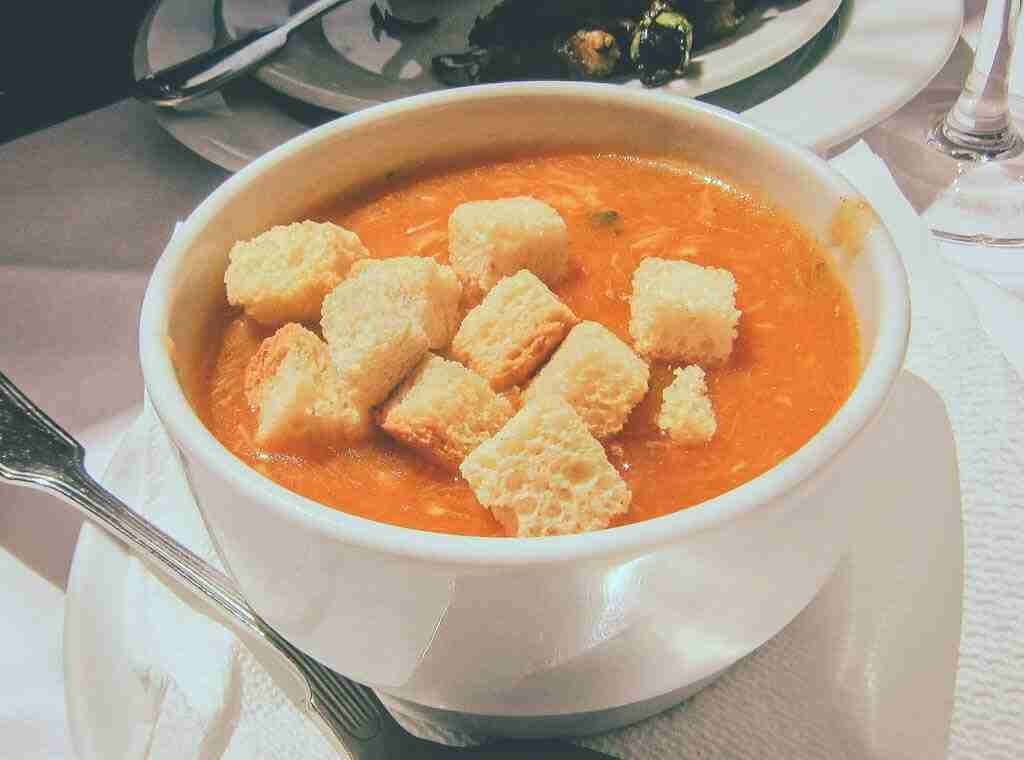
Whilst speaking of seafood, which is also plentiful on the Portuguese table, we have examples of soups coming from Lisbon like sopa de camarão (shrimp soup) or sopa de ostras (oyster soup), but also from the Algarve, which is the case of canja de conquilhas (bean clam broth) and sopa de lingueirão (razor clam soup), and also sopa de lapas (limpet soup) from Apúlia (Minho).

CHORA DE BACALHAU
Regions inhabited by cod fishermen
The Portuguese codfish fishermen that ventured into the cold seas of the north, in particular into the waters of the Sea of Labrador and the Atlantic Ocean surrounding Newfoundland, Labrador, Nova Scotia and Greenland, lived a hard life, with exhausting and relentless work. In the chronic shortage in which they lived in the fishing boats, they ended up creating a series of recipes to repurpose less commercially valuable parts of the codfish, such as the swim-bladder (known as sames), cheeks, tongues, and faces (head). The chora de bacalhau soup is precisely one of there repurposing recipes, which used whatever was in hand on board, which explains the absence of fresh vegetables and herbs. It is an extremely tasty yet simple soup, that makes use of codfish heads (caras), rice, bacon, lard, onion, tomato, bay leaf and garlic.
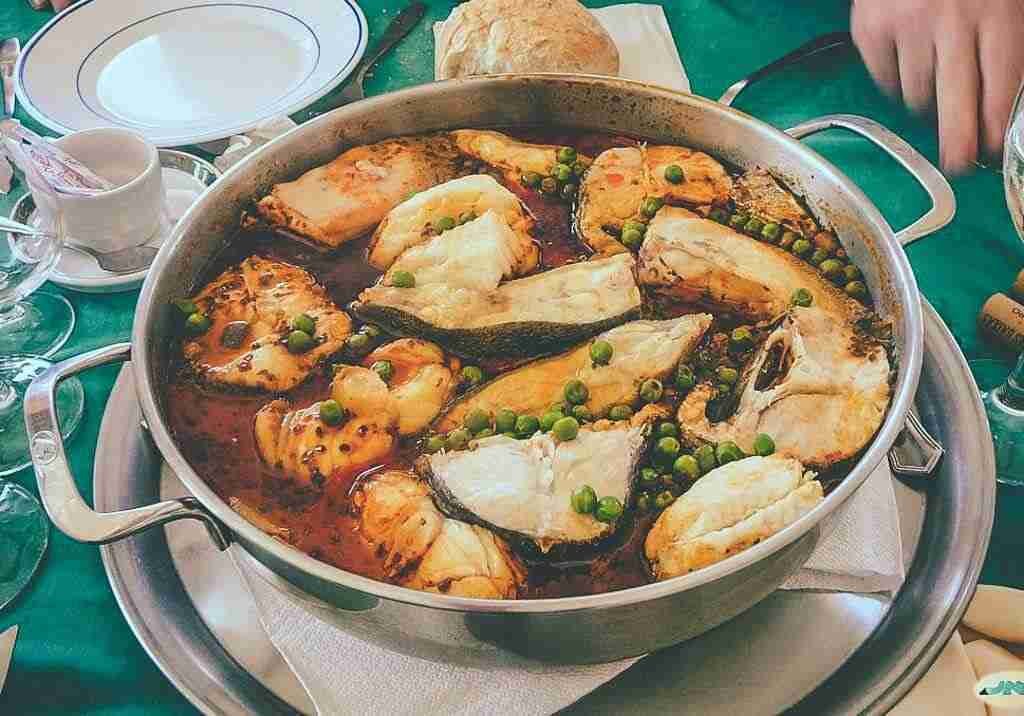
CALDEIRADA
Countrywide
The most complete, celebrated, and plentiful fish soup in Portuguese cuisine is definitely the caldeirada. Present throughout the entire Portuguese coast, this apparent marine amalgam has a bigger structure than you may imagine. The caldeirada is composed of assorted fish, which is gently steamed in their broth. The content of each different caldeirada usually faithfully represents the fish, cephalopod and/or shellfish fauna of the region. Besides the piscine orientation, the caldeirada may or may not include tomato, potato, and a refogado (onion sauteed in olive oil) as a base, as well as other seasonings. Some of the most well-known examples are the caldeirada de enguias (eel) from Beira Litoral, which is an ode to this delicate and precious migratory fish, and also the caldeirada algarvia from the Algarve, which mandatorily contains fish like the dogfish, conger eel, red scorpionfish, and others like ray, monkfish, corvina, and tub gurnard, as well as bivalves like clams, which are then covered with white wine, parsley, tomato, potatoes, and seasoning. The caldeiradas from Ribatejo are also renowned, as is the case of caldeirada à fragateiro, caldeirada à pescador, and caldeirada de bacalhau (codfish). From the Azores comes the caldo de peixe, that uses the local fish like vadigo, mullet, grouper, and sheepshead, and from Estremadura we find caldeirada à moda da Nazaré, caldeirada de sardinha (sardine), and caldeirada à Setubalense. There are many others, all as delicious and interesting as the next, which one should continue to taste, cook, and promote.
As we have seen, soups represent a precious part of Portuguese gastronomic heritage. There is a need to promote and perpatuate the legacy of Portuguese soups so that new generations may have the possibility to taste ancient (and healthy) flavors of our cultural heritage.
References
Rigaud, Lucas (1780) “Cozinheiro Moderno”, Offic. Patriarc. de Francisco Luiz Ameno
Modesto, Maria de Lourdes (1983) “Cozinha Tradicional Portuguesa”, Verbo
Quitério, José (2015) “Bem Comer & Curiosidades”, Documenta
Saramago, Alfredo (1999-2003) “Cozinha do Minho”, “Cozinha Transmontana”, “Cozinha da Beira Interior”, “Cozinha da Beira Litoral”, “Cozinha de Lisboa e seu Termo”, Assírio & Alvim
Valagão, Maria-Manuel “A sopa em Portugal e as sopas de plantas silvestres alimentares.”


Michael OKeefe
What a wonderful article! Can’t wait for soup weather again.
Amass. Cook.
Thank you so much Michael! Us too 🙂